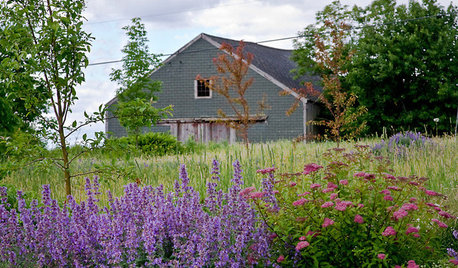Just cleared 8 acres need help planning apple orchard
downeasta
11 years ago
Related Stories

GARDENING AND LANDSCAPINGLandscape Tour: Two Acres of Rural Hillside in Maine
An orchard of crab apples, a grove of sugar maples, even a hayfield ... pastoral landscape beauty doesn't get more idyllic than this
Full Story
MOVINGRelocating Help: 8 Tips for a Happier Long-Distance Move
Trash bags, houseplants and a good cry all have their role when it comes to this major life change
Full Story
GREEN DECORATING8 Questions to Help You See Through Green Hype
With the ecofriendly bandwagon picking up some dubious passengers, here's how to tell truly green products and services from the imposters
Full Story
EDIBLE GARDENSHow to Add an Apple Tree to Your Edible Garden
Readily available, beautiful and fragrant, apple trees offer four-season interest along with crisp, juicy fruit
Full Story
GREEN BUILDINGLet’s Clear Up Some Confusion About Solar Panels
Different panel types do different things. If you want solar energy for your home, get the basics here first
Full Story
LIFE12 House-Hunting Tips to Help You Make the Right Choice
Stay organized and focused on your quest for a new home, to make the search easier and avoid surprises later
Full Story
PETSHow to Help Your Dog Be a Good Neighbor
Good fences certainly help, but be sure to introduce your pup to the neighbors and check in from time to time
Full Story
STANDARD MEASUREMENTSThe Right Dimensions for Your Porch
Depth, width, proportion and detailing all contribute to the comfort and functionality of this transitional space
Full Story
DECLUTTERINGDownsizing Help: How to Edit Your Belongings
Learn what to take and what to toss if you're moving to a smaller home
Full Story
MOST POPULAR7 Ways to Design Your Kitchen to Help You Lose Weight
In his new book, Slim by Design, eating-behavior expert Brian Wansink shows us how to get our kitchens working better
Full StorySponsored
Columbus Design-Build, Kitchen & Bath Remodeling, Historic Renovations
More Discussions








glib
ravenh2001
Related Professionals
Reading Landscape Architects & Landscape Designers · Windham Landscape Architects & Landscape Designers · Ashburn Landscape Architects & Landscape Designers · Leawood Landscape Architects & Landscape Designers · Salisbury Landscape Architects & Landscape Designers · Simi Valley Landscape Architects & Landscape Designers · Stamford Landscape Contractors · Columbine Landscape Contractors · Deer Park Landscape Contractors · Fort Wayne Landscape Contractors · Lynn Landscape Contractors · Mahwah Landscape Contractors · Roswell Landscape Contractors · Secaucus Landscape Contractors · Soddy Daisy Landscape Contractorsalan haigh
windfall_rob
olpea
alan haigh
alan haigh
john_in_sc
ravenh2001
milehighgirl
alan haigh
downeastaOriginal Author
fruitnut Z7 4500ft SW TX
mepop
alan haigh
olpea
queensinfo
downeastaOriginal Author
mamuang_gw
fruitnut Z7 4500ft SW TX
jagchaser
alan haigh
john_in_sc
alan haigh
john_in_sc
alan haigh
olpea
alan haigh
alan haigh
milehighgirl
fruitnut Z7 4500ft SW TX
olpea
alan haigh
olpea
alan haigh
GreeneGarden
alan haigh
GreeneGarden
alan haigh
GreeneGarden
alan haigh
downeastaOriginal Author
olpea
queensinfo
alan haigh
ravenh2001
downeastaOriginal Author
uglyapple
galagala
uglyapple